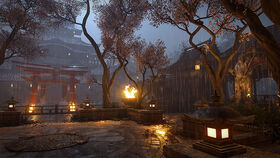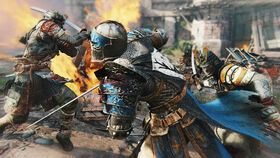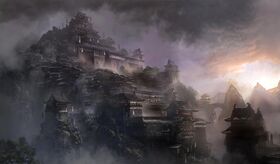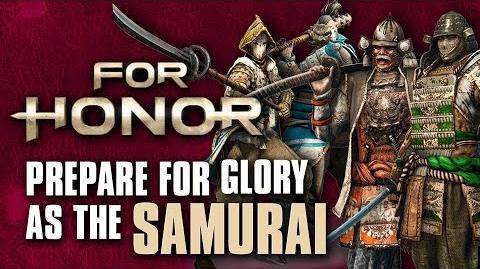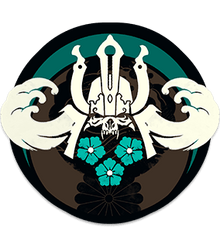
"Cast away from our land, we are rebuilding. Our hearts are strong, our devotion: absolute, and our skill is beyond question. We will be remembered."
The Samurai of the Dawn Empire is one of the three playable factions in For Honor. These people come from a land, far to the East and they tell a tale of a homeland and an Emperor that were lost to sea and fire during the last great cataclysm. Now, more than a millennia later the nomadic warriors roam no more and have rebuilt themselves in a new land with a new Emperor.
After having been driven from their ancestral homes and rebuilding their forces, though strong and mighty, the Samurai still find themselves vastly outnumbered by their new neighbors. Because of this, they know that only through greater cunning, skill and loyalty to each other will their people have a chance to thrive. They may very well be the last of their kind.
Overview
The Samurai are the most unified of the three factions, though this does not say much as the Daimyos were often battling each other for dominance. They are the smallest in number and facing almost constant threat of extinction. They have had to rely on skill, cunning, ingenuity, and determination to pull through. They are led by a single Emperor, the current being Ayu. The Dawn Empire is broken into multiple houses, each led by a Daimyo. The current reigning house belongs to Ayu and is known as The Chosen.
Honor is highly valued amongst the Samurai. They are loyal to the death, battling to defend those they have been sworn to even in hopeless situations, and vowing vengeance should their master be slain. Pride, ambition, and honor seem to be linked as demotion is seen as dishonor to the point the act of jailing a person is considered a grievous insult.[1]
Notable Houses
Symbol
Emblem Significance
- Mastery
- Exodus
- Survival
Colors
- Teal - Immortality and Spirituality
- Brown - Control and Serenity
Classes
| Hero | Appearance | Class | Description |
| Kensei | 
|
Vanguard | The Kensei are as close as one can be to the living incarnation of Bushidō, the Samurai "way of the warrior". |
| Shugoki | 
|
Heavy | The ever-present protectors and guardians of the Samurai, the Shugoki possess incredible strength and an unbreakable will. |
| Orochi | 
|
Assassin | The Imperial assassins of the Samurai, the Orochi roam the battlefield like ghosts, terrorizing and slaughtering those unfortunate enough to cross their path. |
| Nobushi | 
|
Hybrid | Elegant fighters, the Nobushi are the defenders of Samurai villages situated far out in the countryside. |
| Shinobi | 
|
Assassin | Secret and stealthy, the Shinobi are warriors that were once believed to be a myth and strike only when the moment is right. |
| Aramusha | 
|
Hybrid | Samurai who have fallen from grace, the Aramusha return to fight and carve out their own destinies, because it is the only thing they know. |
Equipment
"We are all that remain of an ancient people. That is why each of our warriors must be the match of ten of our enemies. Fearless, disciplined assassins from a faraway land, we fight and die in the name of our ancestors. Our courage is unwavering, our skill unmatched. Masters of war, our blades strike quickly, silently, lethally. For there is no honor in defeat. Are you worthy of the samurai?"
Armor
Their armor is typically made of wood, cloth, and other lightweight materials.
Weapons
Nodachi (野太刀) - All Kensei use this weapon for fighting. It is a much longer variation of the Katana and is used to cleave enemies in a few elegant and powerful strikes. Since it was too large to have it sheathed at one's waist, it was either carried in hand on one one's back. Also known as "Odachi" (大太刀).
Katana (刀) - A traditional Japanese sword. It is considered a hand and a half sword, meaning that it is best wielded by two hands but still can be wielded effectively by one. The blade is curved to maximize cutting power but not curved too far, allowing the Katana's thrust to be just as deadly. The hilt is protected by a circular guard.
Kanabo (金棒; lit. metal bar) - Also known as the "tetsubo" (鉄棒; lit. iron bar), these are clubs ranging from the size of baseball bats to as large as a man, the latter in the case of the Shugoki. These blunt weapons are used to smash armor and break bones. Kanabo are heavy and unwieldy, but when they are swung, nothing can stop them.
Naginata (薙刀) - A Japanese polearm consisting of a long shaft and a curved blade at the end. Allowing extended reach, the blade is capable of cutting enemies at a safe distance and the shaft can be used as a blunt weapon when they get close.
Kusarigama (鎖鎌; lit. chain-sickle) - a traditional Japanese weapon that consists of a kama (鎌; lit. sickle) on a kusari-fundo – a type of metal chain (鎖; kusari) with a small iron weight (分銅; fundo) at the end. The kusarigama is said to have developed during the Muromachi period. However, the game took liberties by substituting a second kama in place of the iron weight.
Kunai (苦無) - A weapon used traditionally for shoveling in farming work, the Kunai is a bladed weapon. The blade is double-edged, and tapers towards the point, providing good piercing abilities. The ring at the other end of the Kunai serves as a counter-balance, along with granting it many other uses, such as becoming an improvised tool for climbing when used with a rope.
Yumi (弓; lit. Bow) - Although Samurai are seen as swordsmen, they are also master archers. They can wield the yumi longbow with lethal accuracy, aiming for the least armored or unarmored areas of an opponent and have been described as being capable of hitting an armored opponent in the eye while from horseback.
Shuriken (手裏剣; lit. hidden hand blade) - An iconic, but historically not an exclusively, shinobi weapon the shuriken is used as a type of hidden blade. The edges of these concealed weapons are sharpened so they can be used to penetrate skin or open arteries. However, Shuriken were better used as distractions than as killing tools.
Notable Samurai
- The Orochi - The main protagonist of the Samurai campaign who was imprisoned after speaking out of turn in front of the Emperor.
- Ayu - A proud Kensei Daimyo who helps The Orochi.
- Dokuja - A pious Kensei Daimyo who laid claim to the Emperor's throne.
- Fujikiyo - A Kensei commander in charge of the waterside Fort Kaiyo Kabe.
- General Tozen - A legendary Orochi who tried to defend Koto from the Vikings.
- Kizan - A greedy Shugoki Daimyo who laid claim to the Emperor's throne.
- Momiji - A bubbly Nobushi under Ayu who assisted The Orochi during the campaign.
- Okuma - A taciturn Shugoki under Ayu who assisted The Orochi during the campaign.
- Ranja - A cowardice Kensei Daimyo who laid claim to the Emperor's throne.
- Seijuro - An ambitious Orochi Daimyo who claimed the Emperor's throne when the new Emperor died.
- Teramori - A Shugoki guard of the Kowareta To monastery.
- Musashi - A Kensei who reportedly decimated the finest swordsmen with the stroke of a thousand cranes.
- Ariwara - Ariwara the Orochi was an assassin and a poet. His songs are still sung today.
- Jubei - As he walked through the fields of Jigoku, Jubei the Kensei saw only ashes.
- Ayame - When Ayame the Shinobi danced, her comrades stood up and cheered.
- Chihaya - As Chihaya the Nobushi pierced the sky, the Gods answered.
- Makoto - As eloquently put by Makoto the Shugoki: the weak are meat the strong eat.
Media
Images
Videos
References
- ↑ Reconnaissance mission, Mercy and Honor Observable







